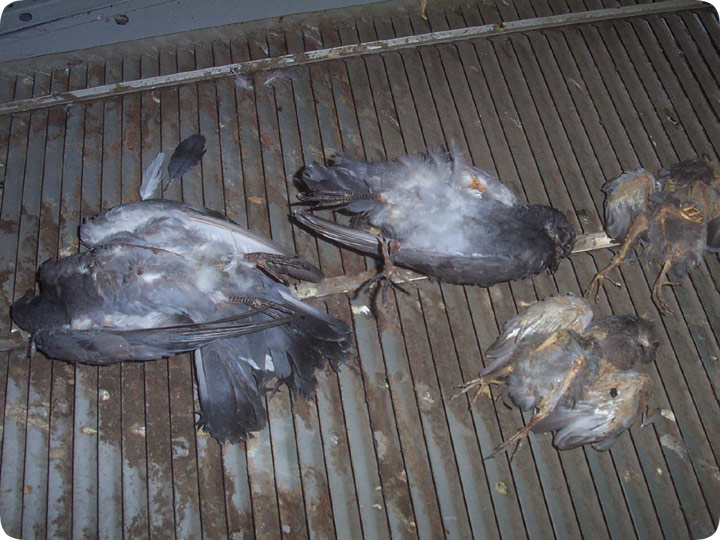-
info@aaanimalcontrol.com
Call us for help in your town
Humane Wildlife Education
Dead Pigeons in Ceiling

11.24.2004 - I found these dead pigeons in the ductwork of a public building. They had an open mushroom vent on the roof, and a large colony of pigeons
was entering the ducts and living there. They made a huge mess in the ducts, complete with nests, eggs, a ton of droppings, and quite a few dead birds. Pigeons
are often filthy animals, and they simply do not keep clean quarters. They don't live long in cities, and like any other wild animal, carry some risk of disease.
They are known, in particular, to be susceptible to salmonellosis, tuberculosis, and ornithosis, but these animals probably just died due to age, or in the case
of the little pigeons, neglect from missing parents. Regardless, it is wise to use precautions when handling dead pigeons. Dispose of them while wearing protective
gloves, and place into thick garbage bags. Avoid breathing in the dust and dander associated with their feathers and droppings.
Diseases Associated with Pest Birds:
Bacterial
Paratyphoid
Vibriosis
Salmonella
Listeriosis
Pasteurellosis
Fungal
Histoplasmosis
Candidiasis
Sarcosporidiosias
Blastomycosis
Viral
Encephalitis
Meningitis
Newcastle Disease
St. Louis Encephalitis
Protozoal
Toxoplasmosis
Trichomoniasis
American Trypansomiasis
Rickettsial
Rickets
Do it yourself: Visit my How To Get Rid of Pigeons page for tips and advice.
Get professional help: Visit my Nationwide Pro Directory of wildlife removal experts.
For more wildlife stories, click my Wildlife Blog
or click my below banner to hire a local trapper.
Pigeons are common nuisance birds that often find their way inside our houses or commercial buildings. They take advantage of small openings and gaps to then nest and roost in a warm, safe space – such as your attic or house ceiling. Unfortunately, pigeons, just like any other type of pests, are not the best housemates. Not only do they make a lot of noise, but they also spread diseases and leave an awful mess behind. Getting rid of pigeons is not always an easy task, but there is even more to do after all the birds are out of your ceiling. Quite often you can find dead pigeon bodies when cleaning after the pigeon extermination. In this article, we are discussing how to deal with dead pigeons safely.
Quick investigation
Firstly, you should take action as soon as you notice signs of a bird presence in your home. You may hear a lot of noises coming down from the ceiling if that's the place where the birds decided to nest. Your investigation should be very thorough – if the pigeons are in your ceiling, there is a big chance they came there through your roof. Identifying entry points is crucial in handling the problem of a bird infestation.
Evicting the birds
There are many methods of evicting birds available, but using a one-way door is one of the most popular ones. It is a safe and humane way of dealing with pigeons in your ceiling. This method allows the birds to leave the space but doesn't let them come back.
Clean Up
You should remember to always wear protective gear when cleaning up after a bird infestation. Old nests left behind can pose a fire hazard and dried droppings still carry harmful pathogens that can be inhaled. This is also the time where you might come across some dead pigeon bodies in your ceiling.
Many times, it is hard to define the cause of death, but it is better not to dwell on such a subject. It is important to dispose of the body quickly and safely as it can still spread illness or parasites.
Wear disposable gloves when handling dead pigeons as mites, insects, and bacteria on their body can be transferred to humans. You should also wear a nose-covering mask, especially when the bird's body is laying around the droppings – dried pigeon feces can turn into a powder that can be inhaled and therefore harmful pathogens can be transmitted.
You should use tools such as a small shovel or rake to move the bird – even while wearing gloves. You must avoid touching the dead body at all times.
Wrap the bird in a plastic bag that can be sealed. If you don't have a bag, you can also use a few layers of newspaper or any fabric.
You should clean up the area thoroughly, including the tools you have used. We recommend sterilizing everything with a solution of one-part bleach to nine-parts water, or stronger.
Always remember to wash your hands with hot, soapy water!




















